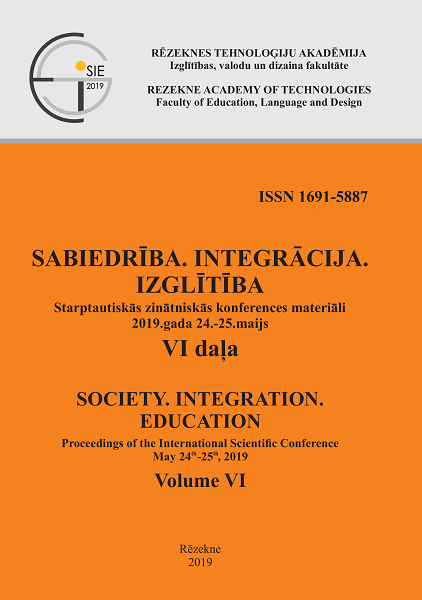CIRCULAR ECONOMY DRIVEN INNOVATIONS WITHIN BUSINESS MODELS OF RURAL SMEs
DOI:
https://doi.org/10.17770/sie2019vol6.3951Keywords:
business model, circular economy, innovation, rural SMEsAbstract
The competitiveness of rural SMEs is low due to economic inefficiency and the lack of innovations. The main challenges faced by rural SMEs are the limited scale, the distance form larger sales markets, R&D and business support institutions, and the lack of innovative spirit. The circular and bio-economies are shaping the rural SMEs towards the environmentally friendly and eco-efficient production, the minimization of the generation of waste and less use of natural resources. This potential of the adoption of new business models within rural SMEs is not fully observed.
The aim of this research is to analyse the opportunities of rural SMEs in introducing the innovative business models driven by the circular economy. This research explores the innovative business models of rural SMEs that transform the environmental challenges in business opportunities and keep a balance with the growing consumption needs. The results of the research are of both theoretical and practical value, providing recommendations for facilitation of innovative business models within rural SMEs. The research methods: desk research, statistical analysis, a grounded theory approach, case study, primary data gathering through seven focus groups with more than 200 stakeholders from six European countries.
References
Bonciu, F. (2014). The European Economy: From a Linear to a Circular Economy. Romanian Journal of European Affairs, 14(4), 78-91. Retrieved from http://rjea.ier.ro/sites/rjea.ier.ro/files/revista/RJEA_2014_vol14_no4_site.pdf#page=79
Ceptureanu, S.I., Ceptureanu, E.G., & Murswieck, R.G.D. (2018). Perceptions of Circular Business Models. Amfiteatru Economic, 20(48), 310-324, DOI: 10.24818/EA/2018/48/310
Costea-Dunarintu, A. (2016). The Circular Economy in the European Union. Knowledge Horizons / Orizonturi ale Cunoasterii, 8(1), 148-150. Retrieved from http://www.orizonturi.ucdc.ro/arhiva/khe-vol8-nr1-2016/30.%20Anca%20Dunarintu.pdf
Drucker, F.P. (1954). The Practice of Management. New York : Harper & Row.
Ellen MacArthur Foundation (2015). Towards a Circular Economy: Business rationale for an accelerated transition. The Ellen MacArthur Foundation. Retrieved from https://www.ellenmacarthurfoundation.org/assets/downloads/TCE_Ellen-MacArthur-Foundation_9-Dec-2015.pdf
Fieldsend, A.F. (2013). Rural Renaissance: an integral component of regional economic resilience. Studies in Agricultural Economics, 115, 85-91. Retrieved from https://ageconsearch.umn.edu/bitstream/149408/2/06-1225-fieldsend.pdf
Foss, N.J., & Saebi, T. (2018). Business models and business model innovation: Between wicked and paradigmatic problems. Long Range Planning, 51(1), 9–21. DOI: 10.1016/j.lrp.2017.07.006
Geissdoerfer, M., Vladimirova, D., & Evans S. (2018). Sustainable business model innovation: A review. Journal of Cleaner Production, 198, 401–416. DOI: 10.1016/j.jclepro.2018.06.240
Giesen E., Riddleberger E., Christner R., & Bell R. (2010). When and how to innovate your business model. Strategy & Leadership, 38(4), 17–26. DOI: 10.1108/10878571011059700
Jorgensen, M. S., & Remmen, A. (2018). A methodological approach to development of circular economy options in businesses. Procedia CIRP, 69(1), 816-821. DOI: https://doi.org/10.1016/j.procir.2017.12.002
Keane, S. F., Cormican, K. T., & Sheahan, J. N. (2018). Comparing how entrepreneurs and managers represent the elements of the business model canvas. Journal of Business Venturing Insights, 9, 65-74. DOI: https://doi.org/10.1016/j.jbvi.2018.02.004
La.lv (2017), Latvijas vērtīgākās zemnieku saimniecības. Rekordiste – Vinteru “Līgo”, Ziņu portals Latvijai la.lv. Pieejams: http://www.la.lv/latvijas-vertigakas-zemnieku-saimniecibas
Lewandowski, M. (2016). Designing the business models for circular economy—Towards the conceptual framework. Sustainability, 8(1), 43. DOI: DOI: 10.3390/su8010043
Magretta, J. (2002). Why business models matter. Harward Business Review. Harvard Business School Publishing Corporation. Retrieved from https://hbr.org/2002/05/why-business-models-matter
Oncioiu, I., Căpuşneanu, S., Türkeș, M., Topor, D., Constantin, D. M., Marin-Pantelescu, A., & Ștefan Hint, M. (2018). The Sustainability of Romanian SMEs and Their Involvement in the Circular Economy. Sustainability, 10(8), 2-19. DOI:10.3390/su10082761
Osterwalder, A., & Pigneur, Y. (2010). Business Model Generation. New Jersey, USA: John Wiley & Sons Inc.
Smallbone, D., Baldock, R., & North, D. (2003). Policy support for small firms in rural areas: the English experience. Environment and Planning C: Government and Policy, 21, 825-841.
Smallbone, D., & North, D. (1999). Innovation and New Technology in Rural Small and Medium-Sized Enterprises: Some Policy Issues. Environment and Planning C: Politics and Space, 17(5), 549 – 566.
Sybimar ltd. Retrieved from www.sybimar.fi/en/closed_circulation_concept
Tambovceva, T., & Tereshina, M. (2018). Economic potential of “green” economy in development of rural territories. Economic Science for Rural Development Conference Proceedings, 48, 259-267. DOI 10.22616/ESRD.2018.092
Teece, D.J. (2018). Business models and dynamic capabilities. Long Range Planning, 51(1), 40–49. DOI: 10.1016/j.lrp.2017.06.007
Uvarova, I., & Vitola, A. (2019). Innovation challenges and opportunities in European Rural SMEs. Public Policy and Administration (accepted)






